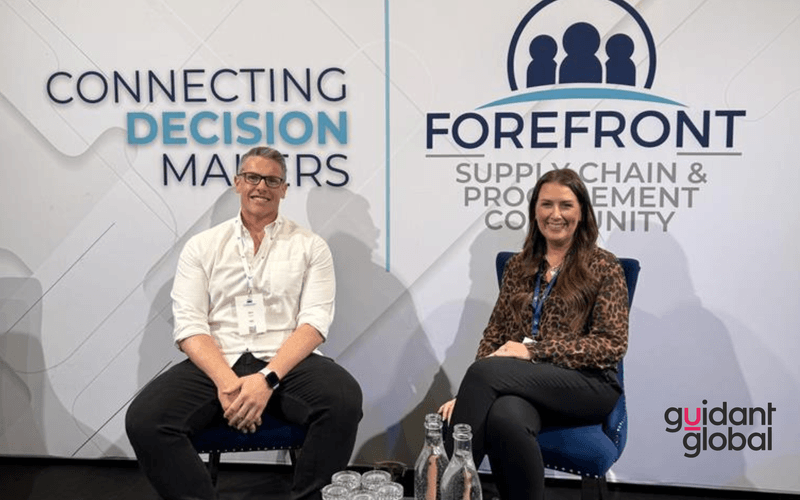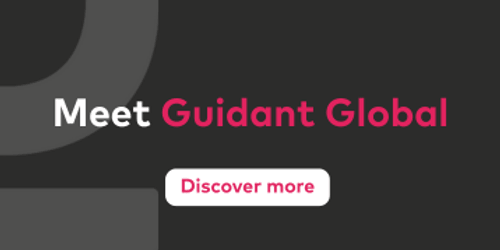

Author
Head of Marketing, Asia Pacific
7 minutes
Unlocking Workforce Transformation - Guidant Global & QBE at the Procurement Summit NSW
When procurement and talent leaders join forces, the conversation shifts from managing the workforce to reimagining it. At the Procurement Summit NSW 2025, this collaboration sparked fresh ideas, bold strategies, and a shared vision for the future of contingent workforce management.
Guidant Global joined QBE on stage for a compelling discussion during the session, “Procurement & Talent Acquisition at the Heart of Workforce Transformation: A Conversation with Guidant Global & QBE” featuring Kelly-Ann Lynch, Managing Director Guidant Global APAC and Ben Girdler, AUSPAC Head of Talent Acquisition QBE.
The conversation ignited insightful reflections on how strategic partnerships and agile workforce models are redefining the future of work. It focused on key topics such as increasing visibility, risk management, operational efficiency, and employee experience.
The keynote centred on QBE’s transformation journey through its MSP partnership with Guidant Global. Ben shared how decentralised recruitment processes had resulted in challenges around visibility, compliance, supplier management, and operational efficiency prompting the strategic shift toward a Managed Service Provider (MSP) partnership.
Key insights discussed during the session:
- Operational efficiency: During the conversation, Kelly-Ann was eager to discuss Ben's perspective on the biggest changes in how organisations are approaching their contingent workforce. Ben highlighted that automation and standardisation have played a crucial role in reducing manual workload and streamlining supplier interactions to deliver smoother, more efficient operations at QBE. He also mentioned how QBE’s talent acquisition team reclaimed time and improved responsiveness to business needs, while maintaining quality and compliance by implementing these changes.
Kelly-Ann and Ben further discussed the goals for the program, and one of the major standout points was driving operational efficiency by automating workflows and reducing manual effort.
- Employee experience: While discussing QBE’s contingent workforce, Ben emphasised that flexibility, purpose, and wellbeing of employees are now central to workforce strategy. The shift toward four-day workweeks, hybrid models, and inclusive hiring practices reflects a broader cultural transformation.
Organisations are reimagining the employee experience to attract and retain talent, especially younger generations who value flexibility, inclusivity, and meaningful work. And he asserted that organisations that fail to adapt, risk losing top talent.
He also mentioned how QBE’s new MSP-led methodology introduced consistency and brand alignment across major processes such as hiring, onboarding, and candidate engagement.
- Workforce visibility: The discussion then led to visibility in terms of managing labour hire procurement. Ben mentioned that QBE’s priority was always to gain a detailed and consolidated view of its contingent workforce, for example - who was engaged, where, and under what terms. Ben explained further that the MSP model brought real-time transparency, enabling faster, better-informed decisions and enhanced supplier performance tracking.
He also noted that, in many organisations, hiring managers often engage contingent workers outside procurement's oversight, leading to challenges with visibility, rate consistency, and governance, key reasons QBE embraced the MSP approach.
To make the discussion more engaging, the audience of procurement leaders at the event was asked to vote on the common challenges their organisations face with their contingent workforce. Interestingly, 54% of the audience voted that limited workforce visibility was their greatest organisational challenge.
- Risk management: The conversation progressed into how teams manage labour hire procurement compared to other categories of spend, highlighting both the similarities and differences. Ben explained that labour hire involves people, not products, making risk management critical. Unlike transactional procurement, it demands oversight of compliance, classification, and decentralised hiring.
Visibility gaps and inconsistent rates pose risks, which QBE addresses through its MSP partnership. He acknowledged that while core procurement principles remain relevant, they must be applied through a more agile, people-focused lens in the context of labour hire.
The procurement leaders in the audience were then asked about their primary focus for contingent workforce strategy in the upcoming year. Interestingly, 35% of the audience aligned on risk management being the primary focus in the coming year.
- Overcoming challenges: During the discussion on QBE’s workforce journey, Kelly-Ann and Ben discussed the challenges Ben was dealing with before he started thinking about partnering with an MSP. He stated that before partnering with an MSP, QBE faced decentralised and inefficient contingent recruitment challenges, with limited visibility over spend, compliance risks, and a heavy administrative burden on the talent acquisition team.
Processes were fragmented across multiple platforms, suppliers were difficult to manage, and compliance with employment laws was challenging. The lack of consolidated data made strategic decision-making difficult. This is where he realised that the team needed a smarter, more scalable approach to talent management that had the potential to improve compliance and support business goals.
- MSP Model Implementation: Next, Kelly-Ann brought the discussion towards the integration of the MSP model. She asked Ben about making the decision to partner with Guidant Global, and what key steps QBE took in their workforce transformation journey. This opened a deeper exploration into the integration journey that followed.
Ben explained that QBE began by reviewing its contingent workforce practices and engaging key stakeholders to identify goals. He explained how their partnership with Guidant Global’s MSP model led to centralise management, streamline processes, and introduce tech solutions, supporting the transition through clear communication and training, and continually refined the model based on feedback.
Ben closed the discussion with a powerful reflection: “The future of contingent workforce management isn’t just about managing spend, it’s about enabling agility and empowering Talent Acquisition and Procurement teams with supply chain management systems that deliver visibility, risk management and bespoke solutions.”
If you're ready to rethink your contingent workforce management strategy, get in touch with Guidant Global to explore how our MSP solutions can support your workforce transformation journey.
Insights to drive workforce performance
Workforce insights in your inbox
Sign up for our newsletter with the latest workforce management news, insights, analysis and more.
Australia
Suite 1403, Level 14
309 Kent Street
Sydney
NSW 2000
United Kingdom
United States
27777 Franklin Road
Suite 600
Southfield
Michigan 48034









